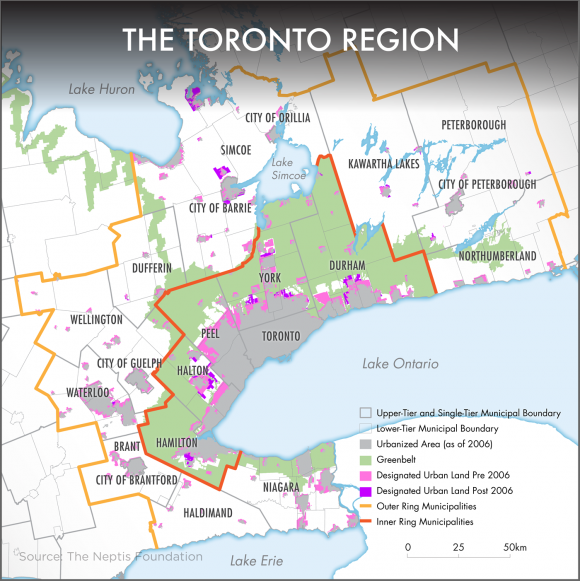Do you remember the future? Flying cars, high-speed trains, and robots servicing our every whim? The Greater Golden Horseshoe or just the “Toronto Region” to the rest of the world, has been Canadas golden child of growth since the 1970s. For decades the region has been an unstoppable economic engine fueled by immigration, industry, and international trade.
For many of those decades I have been blessed to see this rapid growth firsthand from the air as a commercial pilot. Observations that beg the question, what does the future hold for our children and grandchildren? Provincial and Federal government economic predictions expect the Toronto Region to continue to grow rapidly for the foreseeable future. Time for a reality check on what this will mean with a peak into the future.

Current regional development plans combined with technology trends in transportation, logistics and construction enable predictions out to the 2040s. After that demographic, macro-economic, technology and environmental trends provide clues out to the year 2100.

Looking forward 20 years
Spoiler alert, 10 predictions for the year 2043 that I consider a sure bet:
- The Toronto region is turning into a Mega City. Once distinct cities separated by farmland are now merging into one. Call it MegaTor for short. The Ontario government predicts that the Greater Toronto Area population will continue to grow faster than any other metropolitan area in North America. From today’s population of 7 million to at least 10 million citizens by the 2040s. Approaching the population of Tokyo when the first Godzilla film made that city a Mega-icon.
- Winters are warmer, summers hotter, but the Great Lakes have not boiled away and never will. The Increased intensity of extreme weather events will drive more infrastructure investments in the city such as enhanced storm drain systems.
- All forms of electric transportation, cars, trucks, e-bikes, share the streets with a fading number of ICE (Internal Combustion Engine) vehicles. Older diesel TTC (Toronto Transit Commission) buses have been phased out by 2040 with the aggressive adoption of hybrid electric buses. Some buses are fully automated. Wind and solar power supplement a grid still dominated by nuclear power including new smaller modular reactors.
- Canadian regional aviation will hit net zero emissions by 2040, the same year as the TTC. An achievement made even more impressive by the rapid growth in demand. Thanks to good planning and government market incentives, Jet A has been seamlessly replaced with net zero emissions SAF (Sustainable Aviation Fuel). International aviation will follow in 2051.
- Flying taxis and cargo drones will be a common sight in the urban sky but not on your driveway. Dozens of Vertiports are opening across the city with Uber style offerings of UAM (Urban Air Mobility) services. A low altitude UAM traffic management system augments existing air traffic control.
- Yes, you can buy a flying car, but few will. The reason is that you will still need to be a trained and licensed pilot to fly. Transport Canada has spent years certifying and preparing for the new technology. The backlog for new flying cars and commercial drone operating certificates is measured only in months.
- The carbon tax is dead. The Profit motive is driving our economy toward net zero emissions. Net zero products and fuels are demanded by consumers and mandated by regulators. Everything from old long-haul trucks to classic cars can run without any mechanical changes on net zero fuel replacements. Synthetic net zero emissions liquid fuels are a big part of our economy including biodiesel, SAF (indistinguishable from Jet-A), and hydrogen.
- Big oil is as profitable as ever. Oil is being phased out as a fuel but is a key part of 6000 products being consumed and manufactured in the city. A Tesla still needs 700lb of plastic created from oil in its construction. Why would anyone every think that the Canadian oil industry was going to shut down?
- High speed trains to distant cities have not and never will be built. Net zero aviation has made long distance rail obsolete. High frequency rail over short distances is competing with bulk cargo for limited rail line space. NIMBYism (Not In My Back Yard) has made building new rail lines extremely time consuming and expensive.
- The number of fixed wing aircraft in the air has doubled and is maxing out all available airport capacity. This includes a new international airport built in Pickering, that opened in 2029. Local access to long haul fixed wing cargo and passenger aviation is considered key to the success of most businesses. A new federal study starts to look for locations for new airports at the edge of the city.

Figure 3: Population predictions for Canada in the year 2100 by the Century Initiative (next to current population numbers).
Looking further into the future.
What will our city be like on New Year’s Day of the next millennium, the year 2100? When my granddaughter retires, she will want to live in MegaTor. Ten predictions for the city:
- MegaTor’s population growth lived up to the predictions of the Century Initiative peaking at 33 million. Almost as large as the population of Tokyo Japan in 2023. 30% larger than Tokyo in the year 2100.
- Riding the TTC is so easy you never have to look at a transit schedule again. Automated electric city buses arrive every 10 minutes on every street in the city. Automated transit is just one of the draws for young families and retirees alike. The city is overflowing with high-quality low-cost services, and quality employment opportunities. One third of Canadas population of 100 million now lives in MegaTor.
- By the year 2100, all forms of transportation have been electrified and automated. Batteries have the same energy density by weight as liquid fuel. Compact safe fusion reactors are in the process of replacing nuclear reactors. Wind turbines are being decommissioned so the land they occupy can be returned to nature. Solar power is built into everything that needs to be lit up at night including sidewalks, bike lanes and roadways.
- The world has transitioned from climate crisis and population growth to balance. Canada has been creating negative emissions for 50 years. Recycling carbon out of the sky for use as a raw material in construction, plastics and synthetic fuel is big business for Big Oil companies. Climate scientists raise the alarm over a lack of CO2 in the atmosphere causing stunted tree growth.
- MegaTor is an economic powerhouse connected to every corner of a global free market by aviation. Three new airports have been built to handle the 10 thousand daily flights in and out of the city. All electric supersonic flights carry passengers and high value goods around the world. Inside the city over 100,000 UAM flights, including flying taxis, private flying cars, and drones crisscross the sky. They land and take off from two thousand vertiports added to parking garages across the city.
- As population growth reaches balance a young middle-class family will finally be able to afford the house of their dreams and even a fully automated flying car. But most will simply order a flying taxi with the blink of an eye. A blink activating an app on contact lenses connected to the digital cloud.
- The summers are longer, and the winters are shorter as climate change has increased the average temperature by 3 degrees Celsius. MegaTor now has weather like North Carolina had in 2023. Lush city parks and tree lined streets help cool the city. Racoons fight robotic garbage bins for dominance of the night.
- Land called the “Greenbelt” plays an important role in preserving nature in MegaTor by following the outline of the Oak Ridges moraine. The Greenbelt space is no longer wasted on growing low value, ecologically destructive monocrops. Instead, it is utilized for recreation, parkland and organic vertical farming producing fresh vegetables year-round.
- MegaTor’s strong economic performance funds world class health, education, and lowest property taxes in Canada. The city has helped Canada to overcome the weakest per capita economic growth in the G20.
- MegaTor now has three NHL teams. One in Durham region, one in Hamilton and the original Toronto Maple Leaf’s. Spurred on by the new competition, the Leaf’s just might finally have a shot at winning the Stanley cup.

I hope you have enjoyed reading my predictions for MegaTors’ stunning growth in the future. I had fun writing it! If we plan for this amazing growth the results are going to be amazing. This is a challenge we can rise to meet. We need not fear the future.
If we stay focused on good governance and understand our responsibilities, our grandkids are going to be the wealthiest, healthiest, happiest people in history. They will be living in a heaven on earth megacity. A city organized around compact livable green neighborhoods, automated logistics and local accessible aviation. A Mega-Toronto prospering as a vibrant part of a global free market economy. Welcome to the future, may your children live long and prosper.
References:
Why isn’t Canada an economic giant? | Financial Times (ft.com)
Growth planning in Ontario | ontario.ca
The Land Supply Question in the Greater Toronto and Hamilton Area | Neptis Foundation
UAM Vision Concept of Operations UML-4 v1.0.pdf (nasa.gov)
SU0 301207ON ID 006Q (ezsoldhomes.ca)
Visualizing the World Population in 2100, by Country (visualcapitalist.com)
Made from oil and natural gas – Context Magazine by CAPP
The Future of Architecture: Is Graphene the Next Revolutionary Building Material? (architizer.com)
Thanks Mark;
Let’s get specific. Given that Toronto GTAA is legally required to provide a 5 year forecast and is unable to do so why don’t you provide your prognosis of their total aircraft movements for year 2027, 2037. A long term trend line to 2100 would be most informative along with a valid rational for the various airports in the region and their updated capacities.
NO KPMG prognostications. The Minister has already discounted their stuff and seeks to replace the GTAA Chair.
See figure 2 from last year.
https://pickeringairport.org/news-flash-full-aviation-passenger-recovery-in-2023/
This is all hyperbole based on the climate hoax and net zero. You are assuming people won’t catch on to the entire manmade climate crisis thing as one giant scam. Thry already are. 2 Nobel laureates just led a letter signed by 1600 scientists on how it’s a hoax, something you won’t see on the heavily censored legacy media.
It has never been proven in a laboratory that CO2 leads to actiual warming. The opposite is true. Warming by solar cycles relesses more CO2 from oceans and increaes CO2 in the atmosphere. CO2 is a fundamental molecule of life and we should add more of it than less. China knows this which is why they don’t give a rat’s rear about the economic suicide mission known as netzrro.